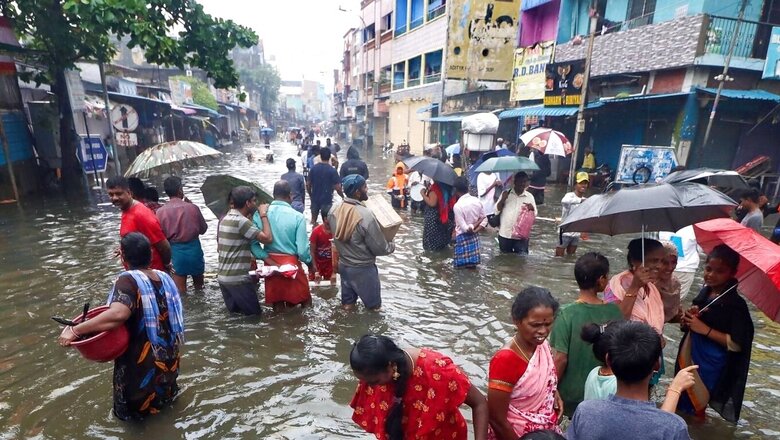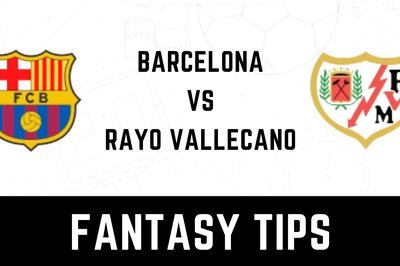
views
As television screens beamed pictures of Chennai submerged in rain waters on Sunday, it took me back in time to December 2015 when an unprecedented downpour drowned Chennai and flooded the city for three days. Chennai, then and now six years later, seems set for an action replay: It could not cope with rains then, it cannot cope with rains now.
Although at first glance, current heavy rain-induced flooding does not appear to be as intense as the one that drowned Chennai and neighbouring areas in 2015, the loss of life is pegged at five. Damage to property, business, and crops is yet to be estimated as the authorities are at present concentrating on relief, rescue, and rehabilitation of people whose houses have been submerged.
Such is the flooding that the Tamil Nadu government has shut down educational institutions in nine districts, and with the weatherman predicting rain for another two days, people look extremely worried. The Met Office has said that Chennai, along with other regions of Tamil Nadu and neighbouring Andhra Pradesh, will get rain for another 48 hours, due to another low-pressure system that has formed over the Bay of Bengal that is set to reach the eastern coast by November 11.
While civic authorities are clearing waterlogged areas on a war footing, the army and NDRF teams have been pressed in for rescue operations, as and where needed. Live pictures on television from Chennai and surrounding regions present a picture of despair, with many areas submerged underwater, uprooted trees, and flooded roads bringing the Chennai city to a halt.
In many parts of Chennai, people have to wade through knee-deep waters to get essential items. Most of the main roads in the city have been waterlogged since Sunday.
If there is rain, there is severe waterlogging; if there is incessant rain, there is flooding; and if there is continuous heavy rain, boats have to be deployed to rescue people from their own homes to safer places.
It was like this in 2015 and the same actions are being replayed in 2021. The only difference: J. Jayalalithaa was then the chief minister, and today it is M.K. Stalin, who is projecting himself as a man of action, standing in knee-deep waters and trying to be seen with the people as opposed to the aloof Amma.
I recall the stories that did the rounds that no one could dare take permission from Amma to release excess water from the Chembarambakkam reservoir. And when water was released from the reservoir, though belatedly, it further added to the excessive rainwater and flooding in the surrounding areas. The government had obviously denied it flatly at that time.
But this time around, Stalin took charge himself and got the best officers on the ground — Chennai Commissioner Gagandeep Singh Bedi, the officer who won laurels when the tsunami hit Tamil Nadu two decades ago.
When I recall my brush with the 2015 Chennai floods, I consider myself lucky as Adyar in South Chennai, where I was living, had minor waterlogging, despite the rainwater swirling into a flood just 200-metre away, submerging houses closer to the Cooum river bank. We were safe in our four-storied apartment building.
Fortunately, we had bought the monthly provisions just the day before and the kitchen was well stocked; there was a spare LPG cylinder too. For two days or so, there were shortages of milk, but then we soldiered on without really having to suffer in any way.
Now, let me tell you something about Adyar. It is a relatively upmarket area, with wide roads and lots of greenery. It is a self-sufficient residential colony, with some of city’s best schools and hospitals within the colony. But located as it is on the bank of river Cooum, it faced flood threats whenever there’s heavy rainfall, often entering the residential areas close by.
In December 2015, it did breach its banks near Gandhi Nagar, just about 1 km away, inundating several houses in Kotturpuram, adjacent to our flats in Adyar. People living in flats of the Housing Board colony had to move to the third floor after the first and second floors came under water. For them, drinking water and supplies of essentials came on boats, if at all, and had to be pulled up in buckets tied with ropes.
The sudden downpour caught each one of us by surprise — and unprepared. But environmentalists were sure that floods were waiting to happen. If and when there is excess rainwater, it has nowhere to go, as most of its pathways leading into the sea were blocked a long time ago by structures, often unauthorised and illegal. Besides, many water bodies were encroached upon by real estate sharks. Even the Tami Nadu government was guilty of erecting a few of its buildings in former water bodies.
In 2015, most of us faced power outages leading to related miseries — no gadgets, no lifts, and even generators fell silent as many were submerged in water. But this time around, many of us were comparatively better prepared; most built elevated platforms for generators so that they are safe this time — a lesson well learnt.
I distinctly remember how difficult it was for me to operate as I was covering Tamil Nadu for Hindustan Times at that time. Coping with a disconnected life was tough, as phones went dead, and battery life in phones and laptops was a big issue as there was no power. Luckily for me, the Adyar Cancer Research Centre across the road, the best and the biggest in India, had its own generator that was functioning. The good doctor in charge there allowed me access to a room with eight plug points for three hours, and I could charge everything, all appliances and power backups, phones. His generosity enabled me to report on the floods.
The writer is a senior journalist tracking social, economic, and political changes across the country, especially Tamil Nadu. The views expressed in this article are those of the author and do not represent the stand of this publication.
Read all the Latest Opinions here




















Comments
0 comment